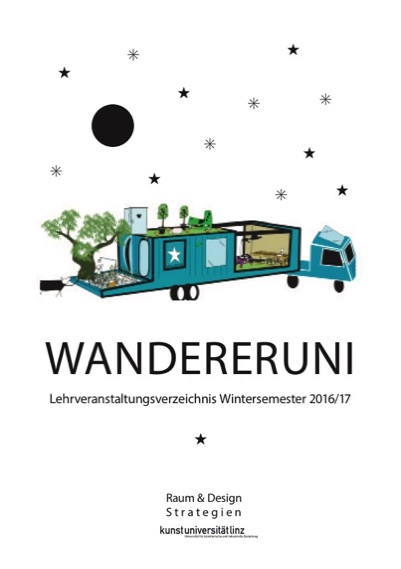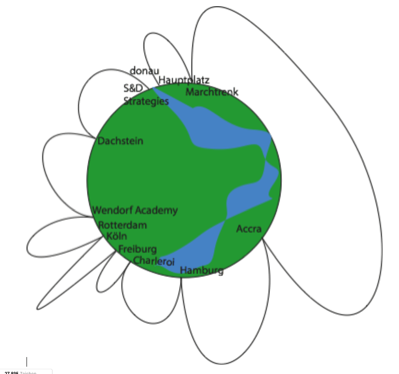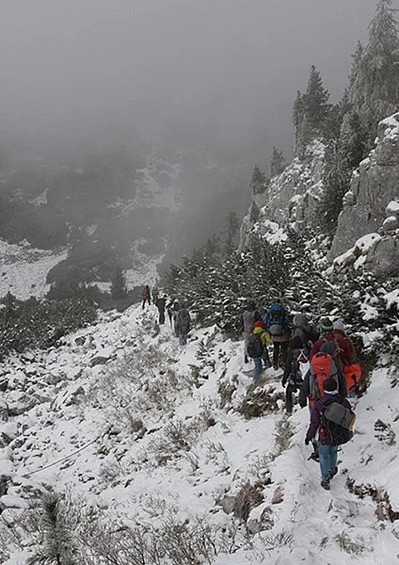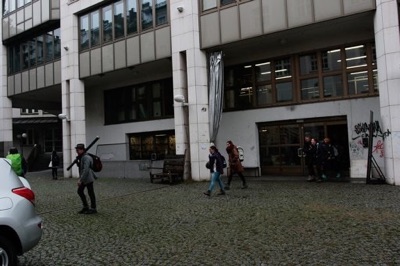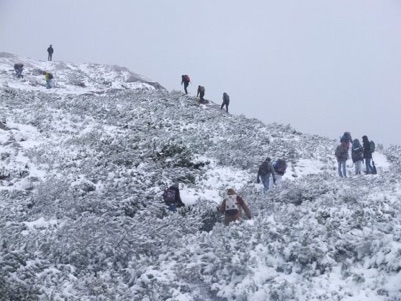indie urbanists

Jahresthema WanderUni
WandererUni rounding the World
Space & Design Strategists of the Art University of Linz (Austria) researched the pores of Austrian Mountains, German cities, an African village and a small Austrian town in an educational wandering tour. A nonlinear geographic travelling to discover, to improvise and to learn from new experiences. This is the essence of performative urbanism. Through new confrontations with reality students subjectivize the circumstances, they attach new meanings and thus improvise our way through the world. This is what space and design practice is about.
The idea of pores, as developed by Walter Benjamin and picked up by Sophie Wolfrum in this research, is helpful to us in guidances this article. The journey is described as a search for new and practical philosophies of space & design STRATEGIES. The key lies in quick changes and confrontations in focus between the local conditions on the spot and the responsive and improvised actions. These actions can be globally inspired as the confrontation between Europan and African locations shows.
1. Identity, space & design STRATEGIES
In 2017 the Faculty of Space & Design STRATEGIES moves across the Danube. From the laboratories in Linz Urfahr in the South the department moves to the main square in the centre of Linz. The direct way over the Danube bridge would be 950 meter. We decided to take the opposite direction: instead of the bridge, we round the world to arrive at the new ateliers via Halle, Freiburg, Cologne (Germany), Charleroi (Belgic), South Africa, Totope (Ghana), Milano (Italy) und Marchtrenk (Austria) at the midst of Europe at the Hauptplatz in Linz. This is a dense summary of this journey.
On our way we developed a view of the identity of space & STRATEGIES. The main goal is clear: a design, based on research, for a better world. This cannot be a theoretical and abstract vision: in confrontation with the local circumstances, we adopt flexibility and apply a talent for improvisation and develop strategies based on doubt and critical thinking.
Beforehand it is good to be aware of the following; we are no urban planners, who generally work in structures and organisation and less in term of daily life and personal experiences. We are no architects, who often develop according to a conceptual design that is still hold on to also when the building does not fit the concepts anymore. Interior architects or designers are we not as well. They start from feelings and emotions and designs often land in the waste bin because they are not beautiful, or don't fit in with these feelings emotions. Are we then artists? Artists work more personal, more autobiographical and therefor more activist, based on direct experiences and local conditions, much more with the always strongly changing present. preliminary conclusion on identity politics: probably space and design STRATEGIES is to be found somewhere in between shaping society, ecological planning and artists' activism. This can only to be experienced through action on location.
2. The fragility of mankind
4-6 October 2016 /
Austrian mountains
snow, storm and very cold
37 Space and Design Strategists feel the power of nature and the fragility of humans and human culture. We are neither in the classic modernist category of recreation nor in a mode of mobility.
At the semesterstart we walked into the Austrian mountains. Some students are familiar here and bounced like goats over the rocks and stones. Others had less experience and walked on linen summer shoes. After a restful night in a Alm shelter (Berghut), we headed for the mountaintop next morning. Quit soon though we were caught up by a snowstorm. After 4 hours climbing ahead, in ever heavier snow, we arrived at a cable car station. Unfortunately it was closed because of unexpected heavy weather. So we had to go on to the next station on the other side of the mountain, another 3 hours by foot, as the men at the station told us without any pity.
Then Waleed stood up. The year before he came as refugee to Europe, by foot and over the Mediterranean by rubber boat, where we accepted him as master student. „if this is the biggest problem“: he said, took his backpack on his stomach, another backpack on his back and the Chinese student who belonged it under his arm. „let’s go!“. And the group went on. Freezed, exhausted and some were crying, but we made it.
This event was a super discovery of the essence of 'wandererUni'. It became clear that our society, our culture, becomes a different meaning, high up in the mountains. Feeling the violence of the mountains, the fragility of mankind, the thinness of our cultural layer. No longer we were in the classical modernistic category of ‚recreation‘, neither did we feel in a ‚mobiliy-mode‘.
We were on our own in a porous mountain chain. Order and disorder no longer exist. Insecurity is not calculable, unlike in the kybernetischen Systemverständnis von Cedric Price und Archichram The world is a process and it is not in our control but there are pores to be discovered and improvised upon with design or Gestaltung.
3. Design deconstructs old meanings
5-9 November 2016
Freiburg, Germany
rain, cold
7 Space and Design Strategists invented an instrument to view the city in a different way and angle. To dismantle conventional ways of urban planning where democratic rules and laws prohibit/deny entrance to certain citizens and to develop new enriching views and interpretations.
When we passed Freiburg we got involved in the preparations of the Dietenbacher Festspiele. A new suburb is in planning, rather classical modernistic, arguments on living, working, recreation and transport, but based on money of investors and sales arguments of comfort. The theatre wanted to research both of the neighbourhoods, Rieselfeld and Weingarten, to generate a program for the new area of Dietenbach. In these preparations some students consider instruments how to research the city in another way. Not to take the capitalist urban-planning-machine for granted. It seems if urban planning is still in this functional order, if not Jane Jacobs asked already for 100 years what actually happens in our cities? We wanted to find new mapping forms to show, with Kevin Lynch, that with functionalism it is impossible to cover the city. We act like in the Chicago school with participative observations.
It is amazing what happens in our mind when our view is redirected with some mirrors shows the work of Ayan. Suddenly the concepts of frog-perspective or bird-eyes-view are realized in front of your eyes and immediately adapted by your brain. To observe the city from the perspective of a mole, an ant, a cat, a giraffe or a drone opens another dimension of perception. The incredible amount of rules and regulations that of course become valid in a new suburb, are questioned in the ‚neulandteppich‘ of Romy. An euclidean space in a tabula-rase-mind, which shows how quick the pores of the city are filled with an acne of laws: where to (not) park the cars, how high the fence towards the neighbours, how far the trees from the facade so the branches would not hit the windows and an employee has to come with a ladder to cut it of and in the meantime the roots of the tree not grow in the sewerage and clog the sewer pipe, when to dispose the empty green bottles, … and when the brown. The ‚newland-carpet‘ is a Lefebrverisch attempt to get in contact with the inhabitants and to get to understand there everyday life in relation to freedom, rules and Utopia. The fear is entitled that the suburb of Dietenbach and many others) are accessible only for a certain clientele, for those who can afford it, who shield with democratic rules and regulations which automatically deny access to others.
4. Rich empty spaces
24-26 November ’16
Halle / Leipzig
Sonne, Kälte Weihnachts Atmosphäre
9 Space and Design Strategists need friends with a power generator and some beers to improvise within the luxury of empty buildings.
The luxury of emptiness is our next research task: whats is the potential of deserted buildings? Both cities, Halle and Leipzig, are literally porous. They are full of Baulücken, Brachflächen und Bruchbuden. For example behind the station, where the infrastructure is bad connected and the verfallene slaughterhouse attracts the attention. No bakery, no supermarket, but the old former GDR eisdiele with the best name (ruf) in town. Here you see the potential of pores in their urban quality, as Walter Benjamin in his notes on Napoli wrote. How sad it may seem, the future-potential is enormous.
You only need friends with a electricity-generator and a 6pack of beer, and then the party in some deserted building starts, tells a leipziger philosophy student with compassion for improvisation.
In der Innenstadt ist mittlerweile sehr viel saniert und in den Hot Spots verkauft die Stadt ihre bei Künstlern und gering bis garnicht-Verdienern beliebten Billigwohnungen, um Raum für junge Familien zu schaffen die gerne den Chai Latte mit Soja Milch für gutes Geld bezahlen. Hier werden die Poren also nicht nur gefeiert, sondern auch von Investoren gestopft. Gentrification ends the creative and open process of filling empty spaces.
5. Nischen, biotopes und pioneers
24 -30 Juni ’17
Köln Mülheim
Extensive rain showers, windy and cold
29 Space and Design Strategists have doubts on the technology cation of laws, neo-liberal market-behaviour and the disappearance of social cultures.
How come that theater-intendants have to care of the future of living in the cities? Isn’t that the job of urban planners? Our performative, urbanistic research project in the village of Gottsbüren 2015, where we with about 40 students squatted some empty houses for a month, brings us the invitation of two theaters to do a research with them. Not only the Theatre Freiburg, the Schauspiel Köln as well invites us to participate in the Festival 'die Stadt von Morgen'.
Two more requests of other small villages already stopped in the first rounds of talking, because of planning-formalities. Do traditional urban planning-amter have more problems with informality and improvisation? Do they still see the city as a ‚piece of work‘ ‚Werk’ in Heideggerschen sinn? Or are they more sensitive for the interests of investors and their lobbyism's?
Under the bridge, in the poring rain, we have a lot of time to doubt the city of tomorrow. And, as university , doubting we should. Exactly that is our task in the contemporary society, where to much research is done in commission with the only goal to prove the hypotheses, instead of requisitioning it and research.
Some students visit a course on hygiene - otherwise it is not allowed to cook in public space - and learn that you should wash your hands before dinner. There was a time, back then when the bridge was being rebuild after the bombing, when no laws where needed and to wash your hands before dinner and while cooking was obvious. Today you have to build an extra Waschbecken. The law does not say that hands should be washed, but obtains the technical neoliberal requirements, that you can wash your hands. The possibility to use one of the 97 wash bins in the houses around is not part of this regulation.Man kann sogar sagen sie wird unterbunden. Es selber haben, anstatt andere zu fragen, das ist das neoliberale Mantra. (bild Coocking)
Despite the demand to transparency we buy ‚gammelfleisch’ clothes made by modern slaves, coffee in plastic paper-cups manipulated VW diesel, obscure finance-papers and so on. So the contemporary politics is based on a wrong statement, which Alan Greenspan, the founder of Neolioberalismus, already 2008 recognised as a lie and apologies in public: the Neoliberalismus is in the end an utopian thought, the consumer proved to buy everything, including the stuff that he don’t wants. Today you start a company, instead of starting a revolution, a company of your own, finding a marktlucke, an empty pore, and tries, with Adorna, the right life in wrong. (das richtige Leben im Falschen). (Bild Barbara)
A Pore has to function as a niche, who delivers the requirements for a protected biotope and so delivers the freedom for the pioneers. So a city needs pores like under the Mülheimer Bridge, where you can kiss secretly (bild yue) or smoke your first cigaret. Or a niche behind the Turkish curtains in the Keupstreet, where you can withdraw (bild 2 Özlem). Therefor the pores has to be discovered and recognise, zB like the empty office buildings at night (bild 3 collage TOM) that are longing to human attention.
In the work ‚Botschaft‘ Embassy (bild 4 Larissa) thousands of rules structures the 12m² representative Embassy and guides the visitors properly through the accurate collection of pictures of the city. The collection changes the perception continually, by sorting again and again. It makes immediately clear, that it is based on subjectivity. So the point of view changes continuously.
The embassy exposes the construct of efficiency, the categorisation and regulation as a questionable attempt to bring order in the city. It is a perception on the city, no ,ore, no less. It is helpful for some, aber blind for a lot. (Hilfreich für einiges, aber blind für vieles.) With the instrumentation maybe everything is "im Griff", but you are working inside your own constructed system, a point of view that leaves the city and its inhabitants and its subjective experiences außen vor.
But what happens when we go under the skin and catch the city inflagranti. By continuous reinterpretation the reality changes constantly, De facto should we recognise exactly this as a design.
What if the subjectification is this important, that you have to do subjective research in a real situation, how consist the possibility diese zu vermittelnde Subjektivität wieder allgemeingültig zu machen, ohne sie abzuschließen?“, asks the urban philosopher and improvisations-musician Christopher Dell, who we meet in a lecture in Köln. How to get into a fluid subjectivity, is a question that asks out attention in the coming semester.
6. City of the future
13 - 30 April ’17
Totope, Ghana:
Sonne, Wärme, Hitze, und mehr Hitze
5 Space and Design Strategists, their skin full of dust, meet the Chief and the Elderly of the Village Totope. Climate change threatens the village through the rising sea level. Finding solutions for the City of the Future become quite a different meaning.
The porosity of the asphalted roads is on our way to the village of Totope to be taken literally. To maintain the technological builded asphalt streets is much more complicated as the sand-roads are. The holes are more edged. How to slalom around can be transformed metaphorically to the society. Almost everything takes place in public space, actually you only goes inside the hut to sleep. Cooking, washing, eating happens in public space. It feels like a mixture of living, working, recreation and mobility, without being able to differentiate the differences. Also shops and workshops are open towards the street, or directly situated on the roadside.
Every product from the Assortiment in our supermarkets is being presented on the street here. Piled on the side of the road, in baskets and plates on the head or in market stands. The saleswoman and man offers their articles in seconds-tact: Deoroller, Biskuits, Taschentücher, Fleischbällchen, Seife, Handtücher, Zahnbürsten, Wattestäbchen, Springseile, Kekse, Currypulver, Schmuck, Röcke, Mais, Äpfel, Zuckerrohr, mehr Kekse, Medizin, Zahnpasta, Brot, Kämme, Malzbier, mehr Deo, noch mehr Kekse, Küchenrollen, Bodyspray, Kopfhörer, Schuhe, Eis, Kleider, Prepaid Telefonkarten, Warndreiecke, Eier, Kokosnüsse, Seile, Chinesische Taschen, Hemden, Avocados, Navy-Gerät-Halterungen, Kaugummis, Landkarten, Koranlehrer, Chips, Taschenlampen, Bananen, Hüte, Radios, Lenkrad-Abdeckungen, Sonnenbrillen, Socken, Gürtel, Unfall-Warnkleidung, schwarze Adidasschuhe, Badelatschen, Damen-Hüte, Düftbäume, Handtücher, Bibliotheks-Bücher, englisch Grammar Schulhefte, Klopapier, …
Full of sweat and dust are the pores of the city, like the pores of our skin. It is impossible to watch through whats taking place, a clear vision on Ghana society seems impossible. All these worlds-problems in a small village alone is to much to deal with, and we from space and design STRATEGIES are overwhelmed at first. It feels like a continuing blur, everything is fuzzy. Here we bounce at the externalisation of the modernistic world. All the waste seems to be outsourced to here
Our first idea, to lift the village we in a museum, on a socle, is received with big applause in the meeting of the elderly men. But that maybe shows more the despair of the villagers as our convincing ingenious. The proposal to explain this idea to Kofi Annan with a local dinner is indeed being accepted very enthusiastic. The elderly Woman start to list immediately what she would offer Kofi Annan for Dinner, together with our students.
Make Fufu not War, is printed on the T-Shirt which our student Lukas bought in Ghana. Exactly this we will try in our next semester.
7 the comfort society
1 - 9 Juli ’17
Festival der Regionen, Marchtrenk:
Sonne, Wärme, Hitze, Regenschauer
All Space and Design Strategist meet in the small Austrian town Marchtrenk in an attempt to research local conditions which seem to be characterised by new dimensions of comfort.
Finally we arrive in Marchtrenk, where the summer festival of the regions took place. Urbanisation there is, like in every city, reached a new dimension. In performative urbanism the students not only try to discover the city of Marchtrenk in an acupunctural way, but also performative really to discover.We enter this deep, that we not only use the toothbrushes of the inhabitants (Projekt BILD MELINA), discover the lonely socks in the wash-basket (BILD ALINA,) but even suck the bacterias out of their dirty carpets (BILD DEBORAH). We hawk with our baldachin through the streets. We collect old television sets,
, out of date medicine, and Glücksbringer. We make photo’s of every house, every fence, and categorise them.We look for black and white pictures, interview the garden Gartenzwerge (bild Steffi), and research the identity based on the ringtones of the door. (bild Cory). We do literally the first step in a new life.
8. Conclusion and Discussion
The cell phones of the Ghanese are the same as those of the Marchtrenker, Kölner or Linzer. We agree with Henri Lefebvre's these that urbanisation of the city and the countryside is the same, as he writes in his book ‚Production of space‘ Maybe we want even to push it one step further and place it on the globalised world. The haircuttings (bild Franziska), the cloths, they are the same in an European city as in a African village. Only the amount of lonely socks differs in Europa from Afrika. What does this mean for our future? How will our life looks like? How will our society function? We are practised in performative urbanism, we can even improvise it. The porosity, the pores of the city, we discovered during the year, thanks to the invitation of Sophie Wolfrum to research this term. We will drill some more holes to make possible, as well in our university, the Distanz und Nähe, Exklusion und Integration, Heterogenität und Homogenität, Anonymität und Gemeinschaft in the future. The task is, as ever, to design our university, not to cooperate with all the problems in the world, so please no Nuclear power, clean drinking water, no plastic waste (not in our blood either) good sewage cleaning, healthy food, printer without dirty ink, cloth not made by modern (child) slaves, and so on… How does an university function in a broad welfare economy ? we will watch and observe this from our Bay Watch in the next semester.
Ton Matton, August 2017
